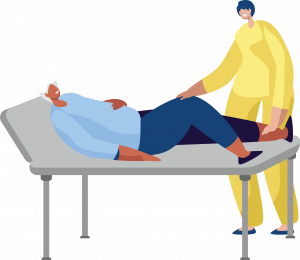Some of the most common issues faced by people ageing with HIV and how to address them
What is HIV?
Human Immunodeficiency Virus (HIV) is a virus that attacks and destroys mainly CD4 cells within the body. CD4 cells are a major part of the body’s immune system and are responsible for fighting infection. When HIV is left untreated within the body, the CD4 cell count can be reduced to such low levels, that the body effectively has no immune system and can develop Acquired Immune Deficiency Syndrome (AIDS).
Anti-retroviral Treatment and U=U
 Thankfully, anti-retroviral treatments (ART) have been developed and become a well-tolerated medication option for people living with HIV (PLHIV). ART interrupts the life cycle of HIV and prevents the virus from being able to attack and destroy CD4 cells.
Thankfully, anti-retroviral treatments (ART) have been developed and become a well-tolerated medication option for people living with HIV (PLHIV). ART interrupts the life cycle of HIV and prevents the virus from being able to attack and destroy CD4 cells.
When an individual takes daily ART, the number of viral copies of HIV in their bloodstream (viral load) begins to reduce and, eventually, becomes so low that it is considered undetectable. When an individual’s viral load is considered undetectable, they cannot transmit the virus. This is known as undetectable = untransmittable or U=U.
This breakthrough in science and medicine has meant thousands of people now have access to a treatment that can prolong their life and prevent the spread of HIV. Though there is still work to be done with providing access to medication to vulnerable countries and populations, those populations that are receiving medication are often still experiencing gaps in medical care and service provision. One gap that is prominent in the HIV sector is the ageing population.
Ageing with HIV can be problematic if carers, family members and physicians aren’t familiar with the common struggles that can be experienced as a person living with HIV ages. This article will outline some of the main issues experienced by those ageing with HIV. The aim of article is to educate the workforce on how to address these issues.
Stigma and social isolation
In aged care facilities, services, and homes
Many people who are defined as ageing today lived through the initial AIDS pandemic.
The fear-inducing messaging and stigmatisation of those infected with AIDS may still be present within both people living with HIV and those that are not. Two phenomena could be intersecting: PLHIV could withdraw from socialising due to perceived stigma and those who are not living with HIV may purposefully or inadvertently express bias, creating unsafe spaces for those living with the virus. Due to this and other factors associated with ageing with HIV, this cohort may be at increased risk of anxiety, depression and other mental and emotional health and wellbeing issues, conditions, and complexities.
Ways to address this include checking the social activities of clients/consumers/patients or communicating with caregivers to ensure clients/consumers/patients are connecting socially with others. Opportunistic education for clients/consumers/patients who express bias can also be helpful in reducing stigma.

In medical settings
The notion of U = U is widely known in medical circles, yet instances of practitioners using extra precautions on top of standard precautions have been reported. When practitioners use extra precautions, it can be hurtful, stigmatising and further enforce conscious or subconscious bias.
Addressing the feelings of apprehension around HIV is important for practitioners to provide an emotionally as well as physically safe service. Approach your local HIV and/or AIDS Council/service or your employer to get details on what training and support services are available to you.
Disclosure and consent
It’s common for people who are ageing to experience conditions which affect the brain and ability to remember information. Such conditions can also alter the person’s ability to give informed consent. This can become an issue when dealing with matters of disclosure of HIV status and family members, care givers or service providers.
A way to address this issue could be to discuss disclosure with your client/consumer/patient or a caregiver you know has been informed before a difficult situation arises. Practitioners visiting homes should take care when handling case notes and always keep them on their person.
Multimorbidity and polypharmacy
Drug-to-drug interactions are more common within the ageing population due to the potential presence of other conditions that may require medications that interact with ART. Patients who have a long history of ART may also experience medication related morbidities.
 PLHIV have a higher chance of instances of comorbidities related to ageing such as increased levels of frailty and other diseases both related and unrelated to HIV including HIV-Associated Neurocognitive Disorder (HAND).
PLHIV have a higher chance of instances of comorbidities related to ageing such as increased levels of frailty and other diseases both related and unrelated to HIV including HIV-Associated Neurocognitive Disorder (HAND).
The complex intersection of these issues can often be missed due to lack of knowledge or education surrounding symptoms and early-detection. Addressing these issues successfully has been seen in practitioners who work collaboratively with caregivers and service providers as well as making referrals to specialists when necessary.
Pill fatigue is a common experience for people living with HIV and taking daily ART. It can become increasingly difficult as people age and experience multimorbidity, resulting in the need for multiple medications to treat different conditions. There are options for those who experience pill fatigue or general difficulty in remembering medication times and requirements.
Practitioners can provide support by taking a proactive approach and starting the conversation with clients/consumers/patients and their caregivers.
Conclusion
Ageing with HIV is a unique and varied experience for each person and requires health care professionals, clinicians, and physicians to have specific skills and knowledge. Without this awareness, people ageing with HIV are at risk of developing further complications which can negatively impact their quality of life.

A holistic team approach is recommended for anybody engaged in the care or support of people ageing with HIV.
Clear communication and awareness of the potential intersecting issues can help support teams to navigate what is still relatively new terrain. Practitioners can best support their clients/consumers/patients by taking a proactive approach to furthering their own education and understanding of HIV in ageing.
Authored by Erika Shaw, Workforce Development Officer
References
- https://www.waac.com.au/wp-content/uploads/2021/09/Aged_Care_Workers_and_HIV_and_Ageing.pdf
- The Kirby Institute (2018). The University of New South Wales, Sydney, NSW, HIV, viral hepatitis and sexually transmissible infections in Australia Annual Surveillance Report. Accessed 12 May 2022 at: https://kirby.unsw.edu.au/report/Aboriginal-surveillance-report-hiv-viral-hepatitis-and-stis-2018
- https://kirby.unsw.edu.au/news/people-hiv-are-higher-risk-ageing-related-genetic-changes
- Woods, R. ‘HIV and Ageing in Australia – The New Frontier’, National Association of People with HIV Australia, 2019, accessed on 12th May 2022 at https://napwha.org.au/wp-content/uploads/2019/04/HIV-and-Ageing-in-Australia-New-Frontier-April19.pdf
- Cysique LA1, Vaida F, Letendre S, Gibson S, Cherner M, Woods SP, McCutchan JA, Heaton RK, Ellis RJ. Dynamics of cognitive change in impaired HIV-positive patients initiating antiretroviral therapy. Neurology. 2009 Aug 4;73(5):342-8.
